IDEA 插件开发
Posted LeBron_Six
tags:
篇首语:本文由小常识网(cha138.com)小编为大家整理,主要介绍了IDEA 插件开发相关的知识,希望对你有一定的参考价值。
文章目录
前言
官方开发文档:http://www.jetbrains.org/intellij/sdk/docs/welcome.html
首先需要开启 Plugin Devkit , IDEA 中默认带了 Plugin Devkit插件,但是没有开启。
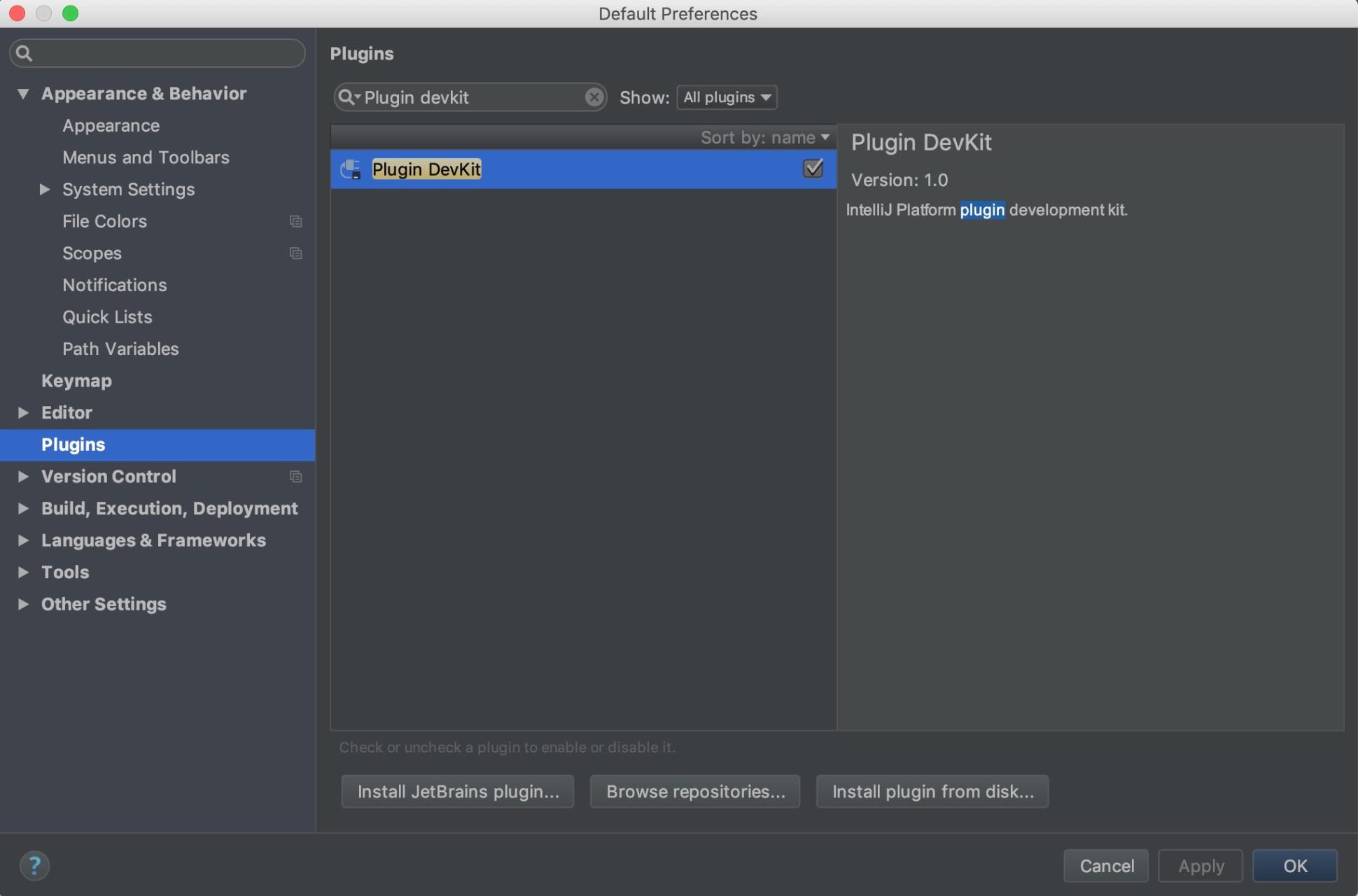
插件工程
创建
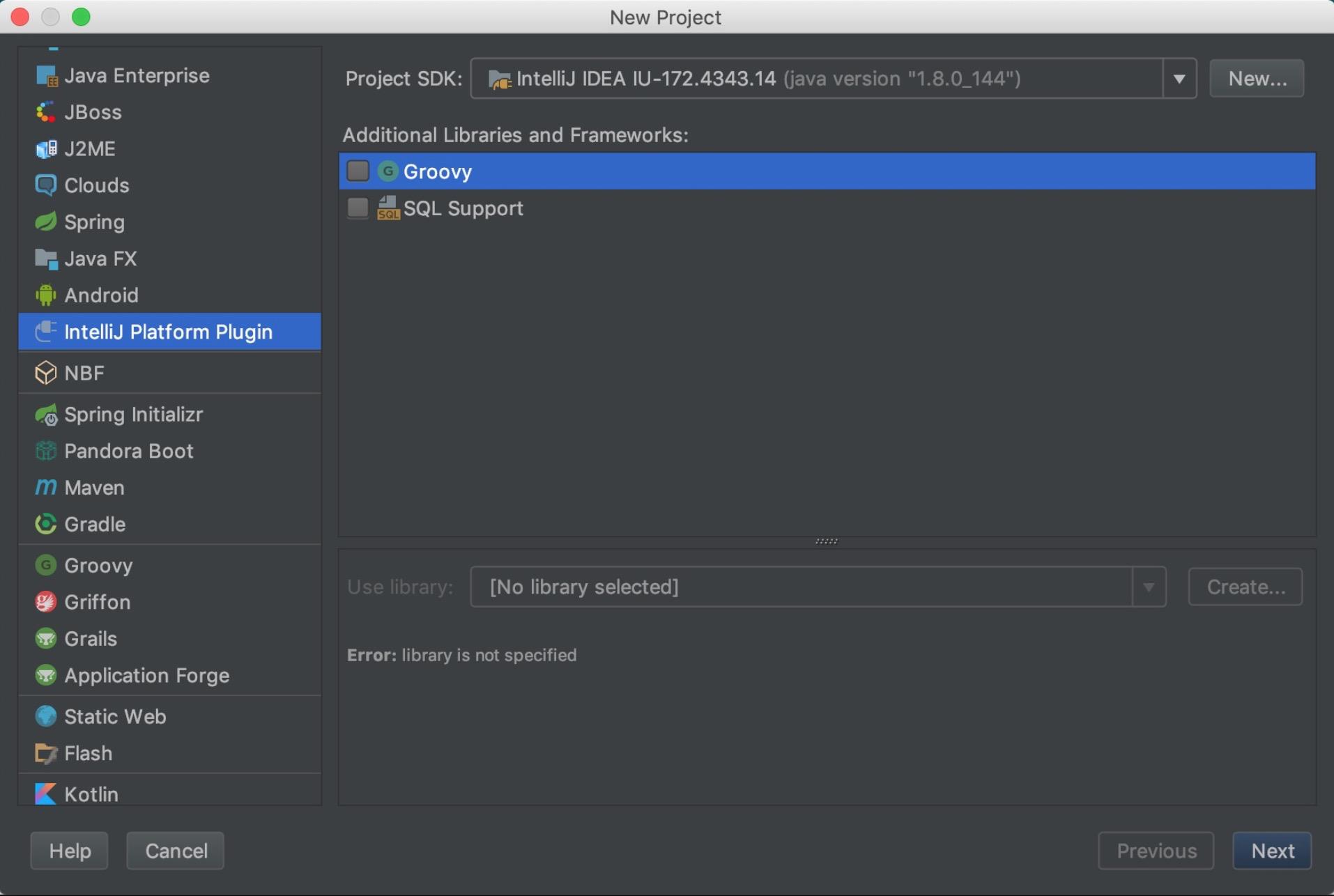

插件工程结构
BundleFileFinder/
resources/
META-INF/
plugin.xml
...
src/
com.yuyang.finder
...
- src 实现插件功能的classes
- resources 存放工程需要用到的资源文件,例如一些引用的jar包、图片资源等。
- META-INF/plugin.xml 插件的配置文件,指定插件名称、描述、版本号、支持的 IntelliJ IDEA 版本、插件的 components 和 actions 以及软件商等信息。
plugin.xml
<idea-plugin>
<!-- 插件相关信息, 会展示在IDEA插件的描述中 -->
<!-- 插件唯一id, 遵循使用包名的原则 -->
<id>com.yuyang.finder</id>
<!-- 插件名称 -->
<name>BundleFileFinder</name>
<!-- 插件版本 -->
<version>1.0</version>
<!-- 开发者信息 -->
<vendor email="smuyyh@gmail.com" url="http://smuyyh.top">$Company|$Name</vendor>
<!-- 插件的描述 -->
<description>my plugin description</description>
<!-- 插件版本变更信息 -->
<change-notes>Initial release of the plugin.</change-notes>
<!-- 如果该插件还依赖了其他插件,则配置对对应的插件id -->
<depends>com.intellij.modules.all</depends>
<!-- 插件兼容IDEA的最大和最小build号,不配置则不做限制 -->
<idea-version since-build="94.539" until-build="192"/>
<!-- Actions: 如添加一个文件右击菜单按钮 -->
<actions>
<action id="FinderAction" class="com.yuyang.finder.FinderAction" text="FileFinder" description="FileFinder">
<add-to-group group-id="ProjectViewPopupMenu" anchor="first"/>
</action>
</actions>
<!-- 插件定义的扩展点,以供其他插件扩展该插件,类似Java的抽象类的功能 -->
<extensionPoints>
...
</extensionPoints>
<!-- 声明该插件对IDEA core或其他插件的扩展 -->
<extensions xmlns="com.intellij">
...
</extensions>
</idea-plugin>
Plugin Action
Action 是什么
Action 用于描述一个动作、行为,可以通过快捷键、点选的方式进行触发。一个 Action 是一个 class,是 AnAction 的子类,actionPerformed 方法在菜单Item或者标题栏按钮被选中的时候会被调用。
Action 允许添加到右键菜单或者Toolbar菜单上面。Action也可以成组添加到具体的一个Group下面。
创建Action
public class FinderAction extends AnAction
private Project mProject;
@Override
public void actionPerformed(AnActionEvent event)
mProject = event.getData(PlatformDataKeys.PROJECT);
DataContext dataContext = event.getDataContext();
if ("apk".equals(getFileExtension(dataContext)))
//获取选中的文件
VirtualFile file = DataKeys.VIRTUAL_FILE.getData(event.getDataContext());
if (file != null)
// 创建面板 java swing
// 后面章节会有 java GUI 面板介绍
else
Messages.showInfoMessage("请选择.apk文件", "提示");
@Override
public void update(AnActionEvent event)
String extension = getFileExtension(event.getDataContext());
this.getTemplatePresentation().setEnabled(extension != null && "apk".equals(extension));
public String getFileExtension(DataContext dataContext)
VirtualFile file = DataKeys.VIRTUAL_FILE.getData(dataContext);
return file == null ? null : file.getExtension();
注册Action
<actions>
<!-- 添加单个Action -->
<action
id="FinderAction"
class="com.yuyang.finder.FinderAction"
text="FileFinder"
description="当前插件菜单功能说明"
icon="icons/garbage.png"
keymap="未知"
popup=""
project-type=""
use-shortcut-of="">
<!-- 将菜单添加至工程的右击菜单 -->
<add-to-group group-id="ProjectViewPopupMenu"
anchor="first"
relative-to-action="GenerateJavadoc" />
<!-- 设置快捷键 -->
<keyboard-shortcut keymap="Mac OS X"
first-keystroke="control alt G"
second-keystroke="C"
remove="true"/>
</action>
<!-- 添加成组的action -->
<group id="FinderGroup" text="组名" description="描述">
<add-to-group group-id="MainMenu" anchor="last" />
<action id="Action1"
class="com.yuyang.finder.FinderAction1"
text="名称1"
description="描述1" />
<!-- 添加分割线 -->
<separator/>
<action id="Action2"
class="com.yuyang.finder.FinderAction2"
text="名称2"
description="描述2" />
<!-- 可以添加一个已存在的action到该group -->
<reference ref="EditorCopy"/>
</group>
</actions>
如果 anchor 设置为 before 或者 after,则必须设置 relative-to-action。
快速创建Action
Plugin Devkit提供了快捷创建Action的方式。
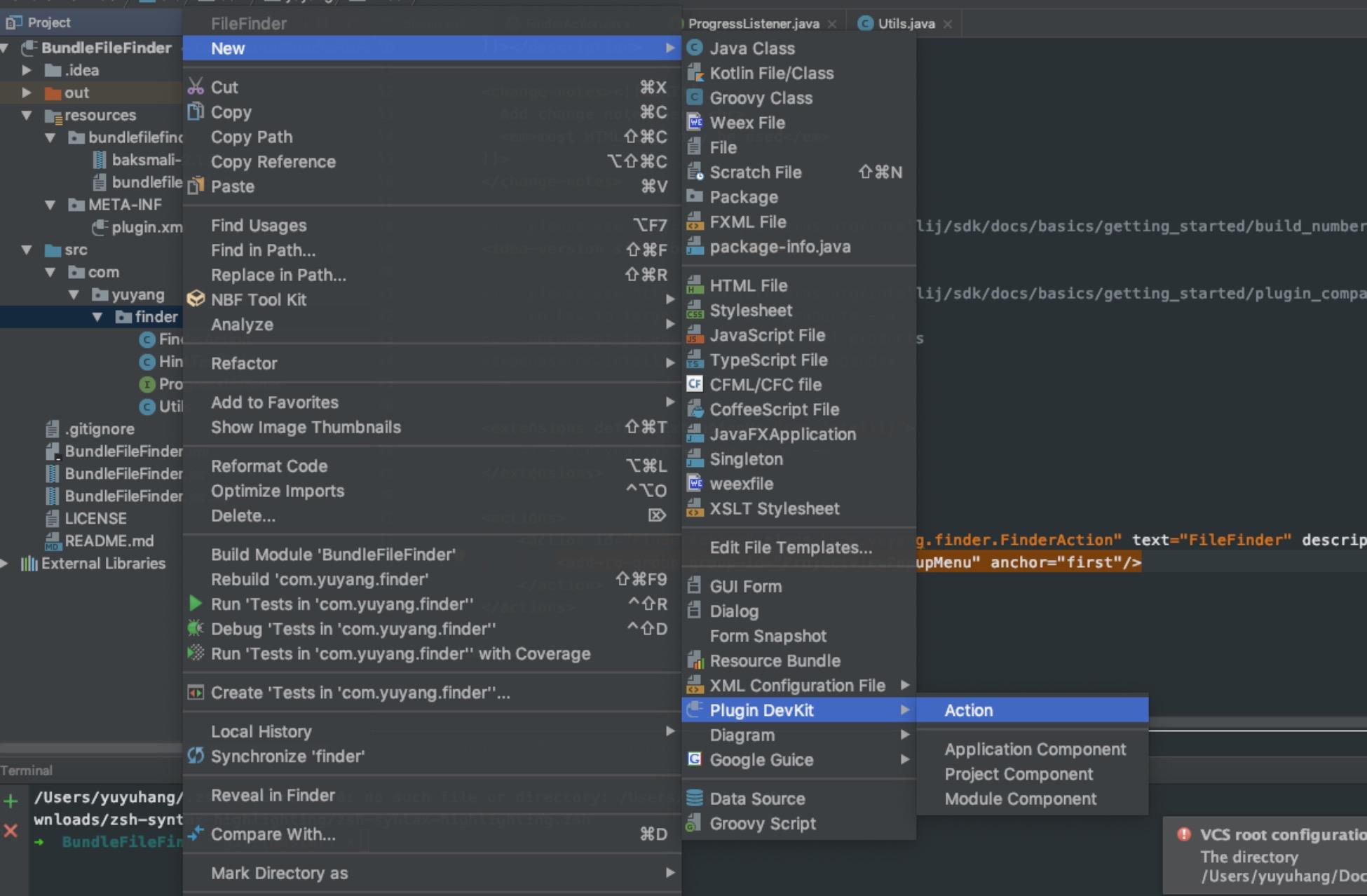
信息填写基本遵循注册Action时的字段内容。
- Action ID: action 唯一 id,推荐使用全类名
- Class Name: 要被创建的 action class 名称
- Name: menu item 的文本
- Description: action 描述,toolbar 上按钮的提示文本,可选
- Add to Group:选择新 action 要被添加到的 action group(Groups, Actions)以及相对其他 actions 的位置(Anchor),比如 EditMenu 就是顶部菜单栏的 Edit 菜单。
- Keyboard Shortcuts:指定 action 的第一和第二快捷键
运行插件
点击 Run | Edit Configurations,若无配置项,则新建一个,配置一下 Use classpath of module,选择要调试的Module。
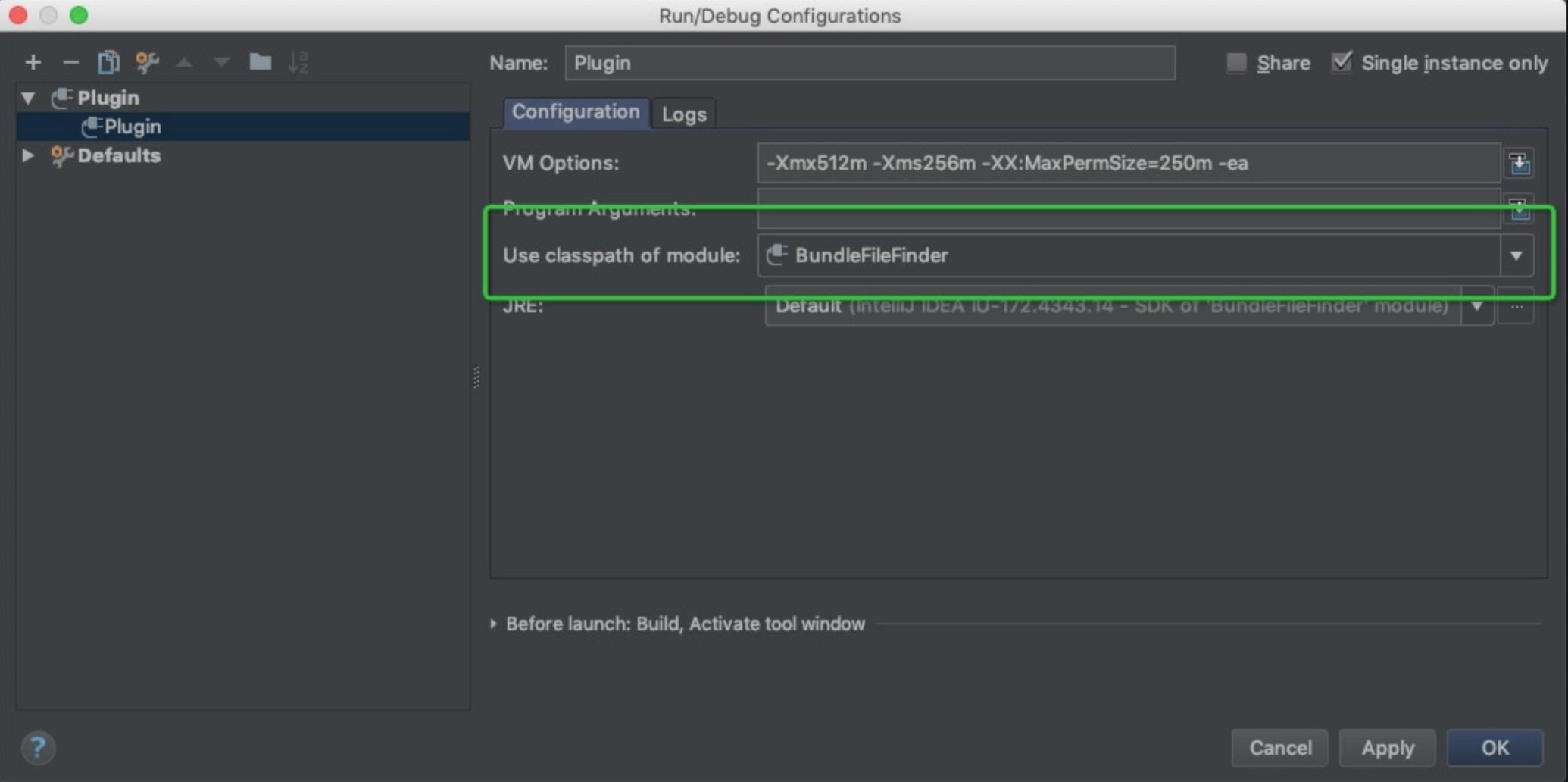
若需要查看调试日志,则需要勾选 Logs的选项。运行插件时将会输出log到console,也可以设置输出到具体文件。

打包插件
Build -> Prepare All Plugin Modules For Deployment,一般会将插件输出到工程根目录底下。

如果该插件没有依赖其他的library,则插件会被打包成.jar,否则会被打包成.zip
.jar 类型的文件内容结构
BundleFileFinder.jar/
com/yuyang/finder/
...
META-INF/
plugin.xml
.zip 类型的文件内容结构
BundleFileFinder.zip/
lib/
lib1.jar
lib2.jar
BundleFileFinder.jar/
com/yuyang/finder/
...
META-INF/
plugin.xml
安装插件
Intellij IDEA -> Preferences -> Plugins -> Install Plugin From Disk,选择打包出来的 .jar 或者 .zip 文件。
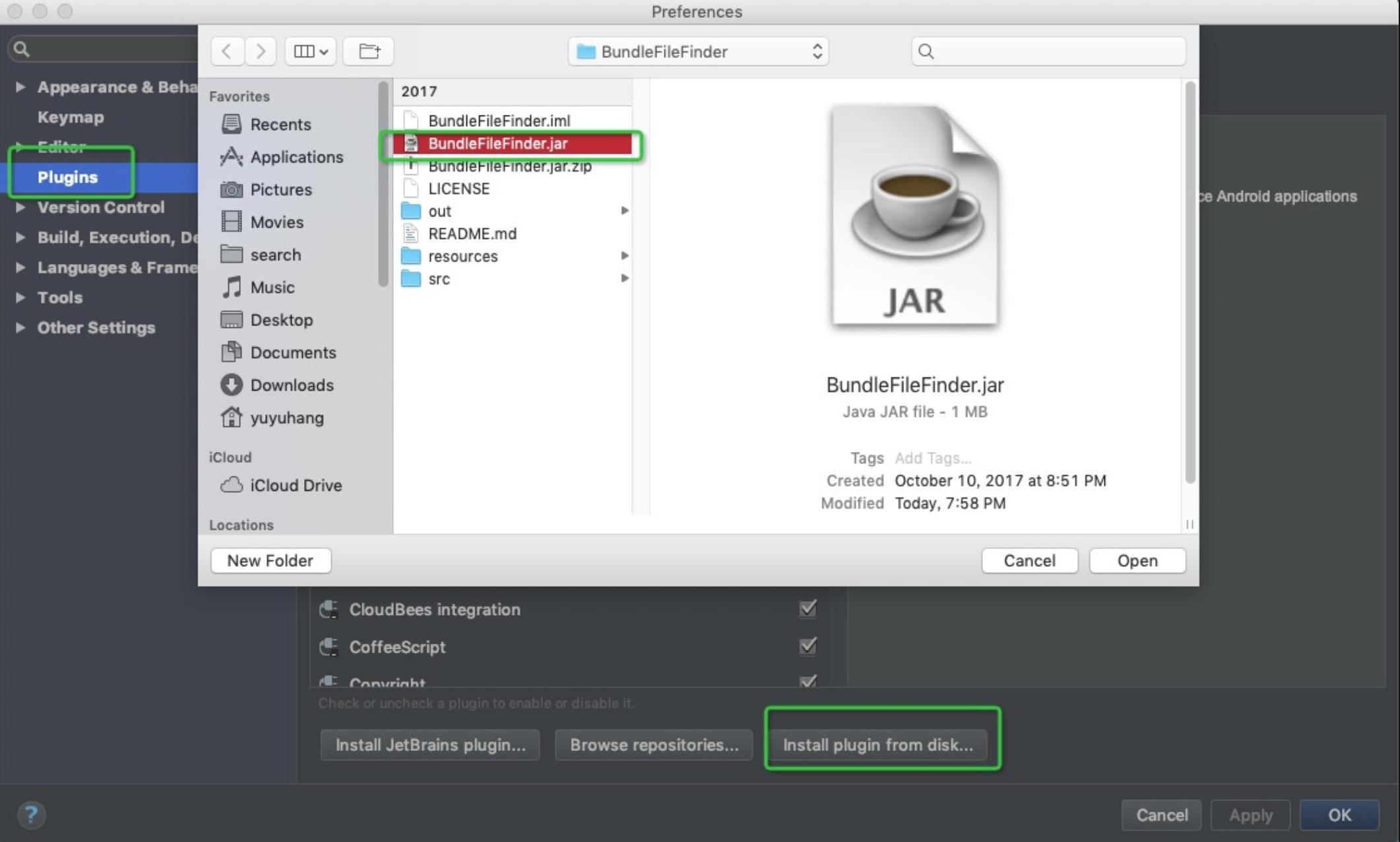
Plugin Components
Components 类型
| Components 接口类型 | 描述 |
|---|---|
| Application Component | IDEA启动时会初始化,IDEA生命周期中仅存在一个实例。 |
| Project Component | IDEA 会为每一个 Project 实例创建一个 Project 级别的component |
| Module Component | IDEA 会为每一个 Project 的加载过的Module实例Module级别的component |
创建 Component
与 Action 一样,可以通过快捷方式创建。 右击菜单 -> New -> Plugin Devkit -> Application/Project/Module Component。
例如创建 Application Component,默认会生成一个 Application 类 和 plugin.xml 的配置
public class FinderApplication implements ApplicationComponent
public FinderApplication()
@Override
public void initComponent()
// TODO: insert component initialization logic here
@Override
public void disposeComponent()
// TODO: insert component disposal logic here
@Override
@NotNull
public String getComponentName()
return "FinderApplication";
<application-components>
<component>
<implementation-class>com.yuyang.finder.FinderApplication</implementation-class>
</component>
</application-components>
Project Component
public class FinderProject implements ProjectComponent
public FinderProject(Project project)
@Override
public void initComponent()
@Override
public void disposeComponent()
@Override
@NotNull
public String getComponentName()
return "FinderProject";
@Override
public void projectOpened()
// called when project is opened
@Override
public void projectClosed()
// called when project is being closed
<project-components>
<component>
<implementation-class>com.yuyang.finder.FinderProject</implementation-class>
</component>
</project-components>
Module Component
public class FinderModule implements ModuleComponent
public FinderModule(Module module)
@Override
public void initComponent()
// TODO: insert component initialization logic here
@Override
public void disposeComponent()
// TODO: insert component disposal logic here
@Override
@NotNull
public String getComponentName()
return "FinderModule";
@Override
public void moduleAdded()
// Invoked when the module corresponding to this component instance has been completely
// loaded and added to the project.
<module-components>
<component>
<implementation-class>com.yuyang.finder.FinderModule</implementation-class>
</component>
</module-components>
获取 Component 实例
例如 获取定义的一个 Application Component 实例:
//获取application容器中的组件
FinderApplication finderApplication = ApplicationManager.getApplication().getComponent(FinderApplication.class);
Project 与 Module
public class FinderProject implements ProjectComponent
private Project project;
public FinderProject(Project project)
this.project = project;
@Override
public void initComponent()
FinderModule finderModule = project.getComponent(FinderModule.class);
也可以通过 AnAction 的事件获取。
public class FinderAction extends AnAction
private Application mApplication;
private Project mProject;
private Module mModule;
@Override
public void actionPerformed(AnActionEvent event)
DataContext dataContext = event.getDataContext();
// DataConstants 被标记为 @deprecated
mProject = (Project)dataContext.getData(DataConstants.PROJECT);
mModule =(Module)dataContext.getData(DataConstants.MODULE);
// OR
mProject = event.getData(PlatformDataKeys.PROJECT);
// mModule = ???
持久化
对于IDEA插件的一些配置,一般情况下都不会希望用户每次使用插件时都要配置一遍,所以 IntelliJ Platform 提供了一些 API,来做数据的持久化。
PropertiesComponent
对于简单的 key - value 数据结构,可以使用 PropertiesComponent,用于保存 application 和 project 级别的数据。用法如下:
//获取 application 级别的 PropertiesComponent
PropertiesComponent propertiesComponent = PropertiesComponent.getInstance();
//获取 project 级别的 PropertiesComponent,指定相应的 project
PropertiesComponent propertiesComponent = PropertiesComponent.getInstance(Project);
// set & get
propertiesComponent.setValue(name, value)
propertiesComponent.getValue(name)
所有的 PropertiesComponent设置的键值对共用同一个namespance,所以需要避免key冲突。
PersistentStateComponent
对于复杂的数据结构,可以使用 PersistentStateComponent,PersistentStateComponent 可以指定持久化的存储位置。
- 需要提供一个 PersistentStateComponent 的实现类,T代表需要持久化的数据结构类型,然后重写 getState() 和 loadState() 方法。T可以是任意的类,或者是实现类自身。
- 若需要指定存储位置,则在实现类上增加 @State 注解
- 若不希望其中的某个字段被持久化,可以在该字段上增加 @Transient 注解
@State(name = "PersistentStateComponentImpl",
storages =
@Storage(value = "PersistentStateComponentImpl.xml")
)
class PersistentStateComponentImpl implements PersistentStateComponent<State>
State myState;
// 当组件被创建或 xml 文件被外部改变(比如git更新)时被调用
public State getState()
return myState;
// 当 settings 被保存时,该方法会被调用并保存状态值。
public void loadState(State state)
myState = state;
class State
public State()
// 支持基本的数据类型、Map、Collection、enum
public String value;
@Transient
public String disableSave;
- 若是 application 级别的组件
- 运行调试时 xml 文件的位置: ~/IdeaICxxxx/system/plugins-sandbox/config/options
- 正式安装时 xml 文件的位置: ~/IdeaICxxxx/config/options
- 若是 project 级别的组件
- 默认为项目的 .idea/misc.xml
- 若指定为 StoragePathMacros.WORKSPACE_FILE,则会被保存在 .idea/worksapce.xml
注册持久化组件
持久化组件可以声明为 Service,也可以声明为 Component,声明为 Component 则与前面介绍注册与获取的方法一致,声明为Service如下:
获取方式为:
<extensions defaultExtensionNs="com.intellij">
<!-- application 级别-->
<applicationService serviceImplementation="com.yuyh.finder.PersistentStateComponentImpl1"/>
<!-- project 级别 -->
<projectService serviceImplementation="com.yuyh.finder.PersistentStateComponentImpl2"/>
</extensions>
GUI 面板
IDEA - Preference - Editor - Gui Designer,勾选 Java Source Code,表示我们通过面板编辑后可以生成 java代码。
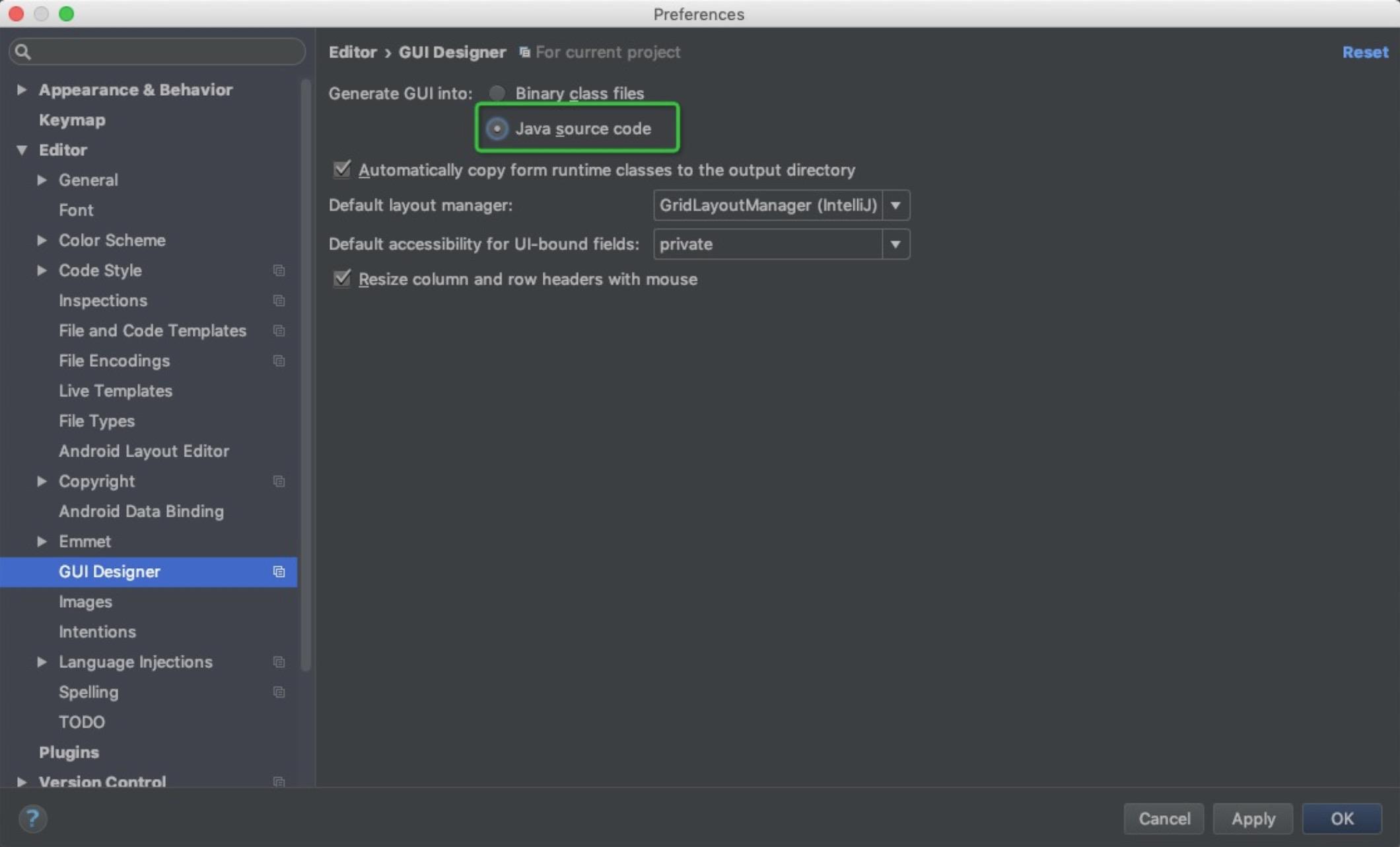
创建GUI Form
指定位置右击 - New - GUI Form

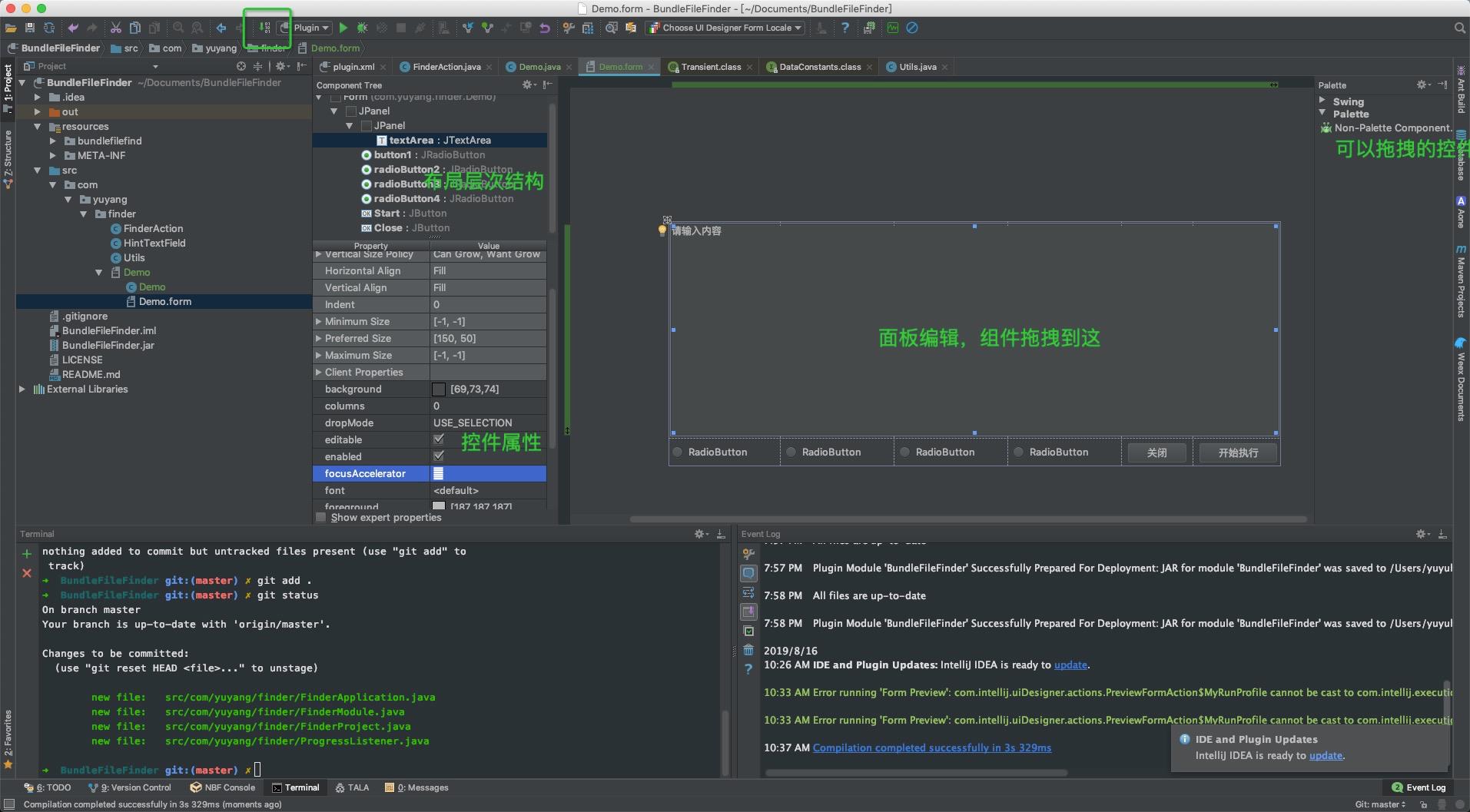
面板编辑完成之后,点击Toolbar工具条那里的 按钮,进行编译。编译完成后,GUI的代码会生成在 对应的 Java文件里面。如图是 Demo.java
按钮,进行编译。编译完成后,GUI的代码会生成在 对应的 Java文件里面。如图是 Demo.java
文件结构
默认根JPanel是没有配置 “field name”控件属性的,所以我们需要给他配置一下。
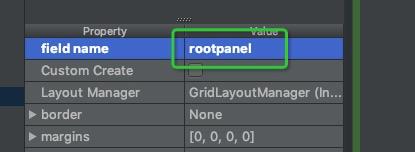
生成的java文件如图,$$$setupUI$$$() 方法里面是具体创建布局的代码。
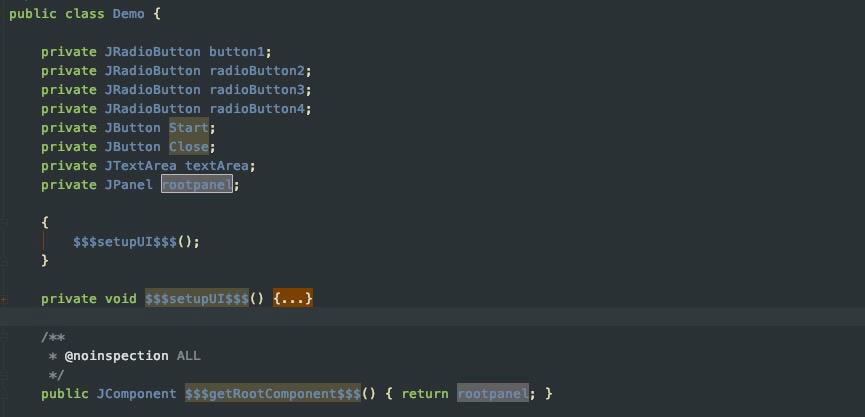
布局预览
在需要插入main方法的地方,按下 Command + n,点击 Form main,则会生成可执行的main方法。

运行 main 方法,可以预览之前创建的布局。


插件上传
插件也支持上传到 idea 仓库,让其他人搜索到。
官方文档:http://www.jetbrains.org/intellij/sdk/docs/basics/getting_started/publishing_plugin.html
示例项目
实现反编译APK来查找是否引用了某个类;
仓库地址:BundleFileFinder
参考:https://cloud.tencent.com/developer/article/1348741
以上是关于IDEA 插件开发的主要内容,如果未能解决你的问题,请参考以下文章
技术调研,IDEA 插件怎么开发「脚手架低代码可视化编排接口生成测试」?